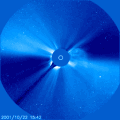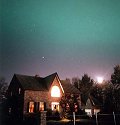What's Up in Space -- 23 Oct 2001
Subscribe to Space Weather News!  HERE COMES THE SUN (AGAIN): A pair of coronal mass ejections (CMEs, pictured right) are heading for Earth following two explosions above sunspot 9672 on Monday, Oct. 22nd. The expanding cloud(s) will likely strike our planet's magnetosphere on Oct. 24th or 25th and trigger a new round of geomagnetic activity. HERE COMES THE SUN (AGAIN): A pair of coronal mass ejections (CMEs, pictured right) are heading for Earth following two explosions above sunspot 9672 on Monday, Oct. 22nd. The expanding cloud(s) will likely strike our planet's magnetosphere on Oct. 24th or 25th and trigger a new round of geomagnetic activity.
The CMEs billowed away from the Sun yesterday following (but not necessarily caused by) two solar flares: an M7 flare at 1508 UT and an X1 flare at 1750 UT. If the second CME has overtaken the first, then the incoming cloud would be a "cannibal CME." Such CMEs are thought to be effective triggers of Northern Lights.  NORTHERN LIGHTS: A geomagnetic storm that began on Oct. 21st is finally subsiding. Sky watchers at high latitudes (including the northern tier of US states) have enjoyed a vivid display of Northern Lights -- visit our aurora gallery and see them for yourself! NORTHERN LIGHTS: A geomagnetic storm that began on Oct. 21st is finally subsiding. Sky watchers at high latitudes (including the northern tier of US states) have enjoyed a vivid display of Northern Lights -- visit our aurora gallery and see them for yourself!
Monday's storm was triggered by solar activity: twisted magnetic fields above sunspot 9661 erupted powerfully -- not once, but twice -- at 0105 UT and again at 1635 UT on Oct 19th. Both explosions unleashed category X1.6 solar flares and hurled lopsided coronal mass ejections (CMEs) toward Earth. The first of the expanding clouds hit Earth's magnetosphere on Oct. 21st at 1650 UT; th |

